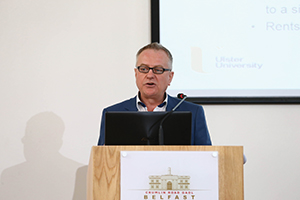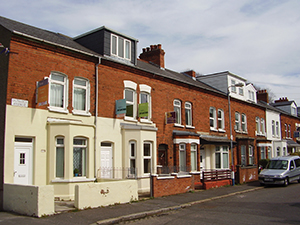The forgotten social housing sector
Professor of Housing at Ulster University Paddy Gray addresses the Northern Ireland Housing Conference about the low income households in the private rented sector.
 Paddy Gray recalls growing up in a “tin town” estate in Armagh made up of 20 aluminium bungalows with lawyers and unemployed individuals living side by side. The 1980s and 1990s saw a change in housing with a shift in subsidies from housing to the person through the housing benefit. Gray also outlined a number of other changes. “Those who are in higher incomes have been pushed out of social housing. The private rented sector has seen major growth and is now three times larger than 15 years ago. The net effect has been residualisation of social tenants; higher concentrations of low income and vulnerable groups in social housing.
Paddy Gray recalls growing up in a “tin town” estate in Armagh made up of 20 aluminium bungalows with lawyers and unemployed individuals living side by side. The 1980s and 1990s saw a change in housing with a shift in subsidies from housing to the person through the housing benefit. Gray also outlined a number of other changes. “Those who are in higher incomes have been pushed out of social housing. The private rented sector has seen major growth and is now three times larger than 15 years ago. The net effect has been residualisation of social tenants; higher concentrations of low income and vulnerable groups in social housing.
“Social landlords are now increasingly relying on rental income to invest in and maintain and manage their stock as well as securing private finance for new build,” explains Gray.
Talking about the current situation, Gray explains that Northern Ireland Housing Executive (NIHE) rents have been kept artificially low over recent years. The current weekly average is £63.46 compared to £94.13 for housing association tenants. The Department for Social Development recently outlined proposals for a social rent setting policy including a benchmark rent as an indication of an affordable and appropriate rent. For 2014-15 this was to be £90.27 per week and would be updated annually. NIHE rents planned to gradually increase to reflect the benchmark rent. However, these plans have been parked while the implications of the social rent cuts in England are analysed. The Minister has announced a rent freeze for NIHE and requested that housing associations do the same.
Gray looks briefly to the situation in England. The UK government recently announced that social rents will reduce by 1 per cent per annum for the next four years. There are also plans to extend ‘pay to stay’ which will require social tenants with a higher income above £30,000 per year to pay a market rent. “This could lead to further erosion of high incomes in social housing groups,” he comments.
The NIHE has previously relied heavily on house sales income for investment but this dried up as the market went downhill. The Savills House Condition Survey 2015 stated that £6.7 billion investment in NIHE stock was needed over the next 30 years. There has been significant underinvestment since 2009 and nearly half the stock needs immediate investment. Gray told delegates that “the recently announced rent freeze will mean an immediate shortfall of £10 million per year from the 3.8 per cent increase that was proposed.”
Rents have increased at a very slow level in Northern Ireland in comparison to a similar region in England where rents have increased by 60 per cent between 2003 and 2013. In contrast Northern Ireland has only seen a 37 per cent increase. Gray comments that “85 per cent of those in NIHE housing receive full housing benefit.”
Housing associations have higher rents but this includes service charges and newer stock. Gray states housing associations are “lumbered with a mixed funding mode of roughly half grant half private finance.” Associations have seen over £600 million investment to date but this has to be paid back and they must roll out community investment initiatives through housing plus activities.
Gray stresses that the associations need sustainable long-term income streams whilst banks and other funding sources need assurances. He asks: “Are they public bodies or not? Can they be forced to borrow private finance yet have their income streams controlled? Should rents be linked to performance? Certainly more transparency is needed.
“The easy option is to freeze rents or reduce without considering the long-term consequences. It is not a popular decision to increase rents but where does the money for investment come from? They can’t expect to reduce income streams and at the same time cut public sector investment. In an ideal world we would be back to 100 per cent but that is never going to happen! Why are the 70,000 low income tenants in the private rented sector treated so differently?”
 Gray outlines an example of two families who apply for social housing, one is successful and the other is signposted to the private rental sector. The social tenant qualifies for a possible £24,000 discount; receives relatively lower rent with the majority not paying any shortfall between housing benefit and actual rent; a guaranteed security of tenure; a high standard of housing management; avails of community investment initiatives through housing plus. “What does the private rental sector tenant at the same income get? Nothing. I call it the forgotten social housing sector.”
Gray outlines an example of two families who apply for social housing, one is successful and the other is signposted to the private rental sector. The social tenant qualifies for a possible £24,000 discount; receives relatively lower rent with the majority not paying any shortfall between housing benefit and actual rent; a guaranteed security of tenure; a high standard of housing management; avails of community investment initiatives through housing plus. “What does the private rental sector tenant at the same income get? Nothing. I call it the forgotten social housing sector.”
He poses the question: “Should tenants pay for what they get?” More than 75 per cent of tenants in the private rented sector are paying above £90 a week. Three out of five private rented sector housing benefit recipients are paying £20 plus in difference between housing benefit and actual rent, whilst 85 per cent of housing benefit recipients in NIHE get their full rent paid.
Nearly half of private rental sector tenants choose to enter the private rented sector for neighbourhood/family reasons among other factors. “Should rents be linked to location? Should everyone pay something which would keep the housing benefit bill down but mean that more income can be generated? This wouldn’t be popular politically but why treat low income residents in the private rental sector differently? My own view is that there is plenty of scope to allow rents to rise to housing association rates and allow the housing benefit to support this,” he contends.
What next?
“Unfortunately we are again treading water given the recent announcement of a rent freeze despite the evidence put forward for rent increases to pay for the investment that is required. We are also treading water regarding the status of the NIHE and it has to be time to take it out of the public sector borrowing requirement. We cannot move towards a single social rent but we can encourage tenants to get involved in setting rents and service charges with greater transparency so they know exactly what they will get for the rent increases.”
Gray concludes: “The private rented sector is continuing to grow and is expected to account for more than a third of all households by 2032 so why are low income groups there treated differently and how are we going to help them? Personally I would want a return to 100 per cent capital funding, large scale building of social housing to meet the increased demand, low rents attracting mixed income groups and win a £1 million on the lottery… Dream on, Paddy!”





